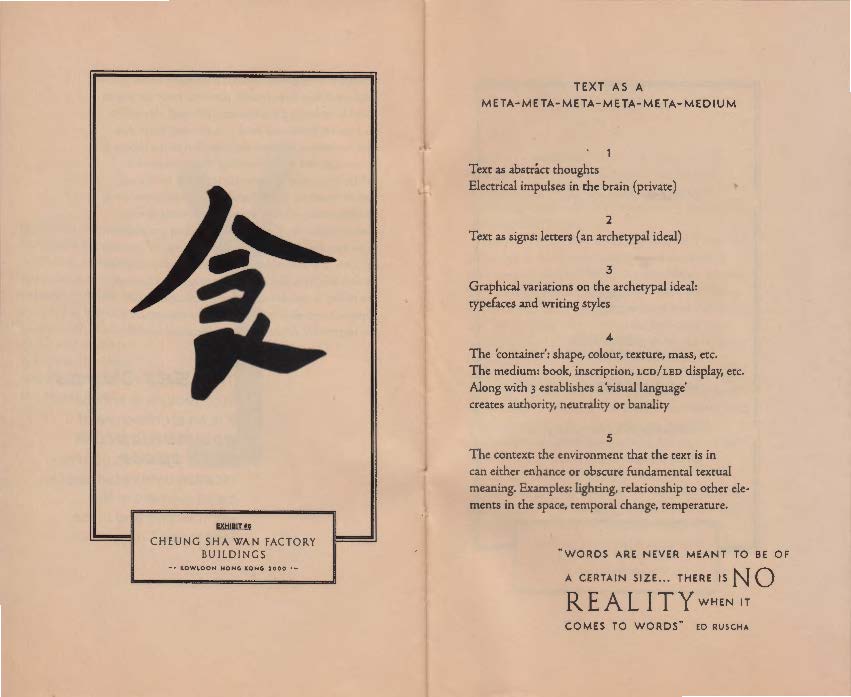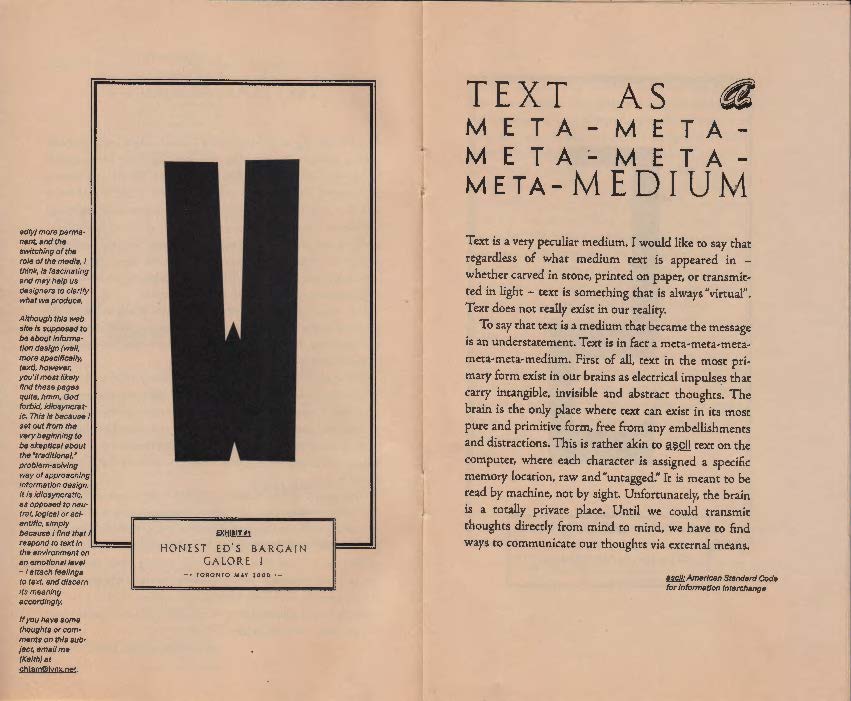

Apparently the seed for this project was already planted 20 years ago. Posting something this old poses the risk of making a fool of myself, but I’ll do it anyway.
This was from one of my grad projects when studying at Emily Carr. I proposed that ‘text’ is always ‘virtual’ (non-material?), and that it is a meta (x5) medium. Apparently I also treated the accompanying website for my project an ‘electronic sketchbook/composition book’, so this is site really is nothing new.
These rather half-baked thoughts from 20 years ago are what would now be called geosemiotics, a branch of linguistics and an extension of the study of multimodality. See Discourses in place: language in the material world by Ron Scollon and Suzie Wong Scollon, where they look at interaction order, visual semiotics and place semiotics.
(to save myself from further embarassment, I won’t upload the horribly dated website)
Text as a Meta-meta-meta-meta-meta-medium
Text is a very peculiar medium. I would like to say that regardless of what medium text is appeared in – whether carved in stone, printed on paper, or transmitted in light – text is something that is always “virtual” – text does not really exist in our reality.
Text is in fact a meta-meta-meta-meta-medium. First of all, text in the most primary form exist in our brains as electrical impulses that carry intangible, invisible and abstract thoughts. The brain is the only place where text can exist in its most pure and primitive form, free from any embellishments and distractions. Unfortunately, the brain is a totally private place. Until we could transmit thoughts directly from mind to mind, we have to find ways to communicate our thoughts via external means. In order to solve this problem, humans then devised ways to code these thoughts in graphical forms – the written languages. As soon as we transcribe our thoughts onto a two-dimensional surface using a written language (making it public), a number of factors begin to come into play. First and foremost, there is the code that tells us that “this is something that can be read, in this particular way.” In order to be recognized as such, a text has to follow a pre-defined set of rules that governs the basic construction and arrangement of each letter (in the case of the Latin alphabet). Meanwhile, the idiosyncratic decisions that we make when transcribing text gives it another dimension of meaning – the typefaces or styles of writing. This is another level of coding that may or may not be decoded by the reader. Then there is the container as mentioned above – the shape, the texture, the mass, the colour etc. And finally, there is the environment (the context) that the text is in – how other elements in the environment enhance or fight with the text, and how other external factors such as lighting, temperature, the obscuring of the text affect the perception of the text.
1
Text as abstract thoughts in the mind (private)2
Text as signs: letters (an archetypal ideal)3
Graphical variations on the archetypal ideal: typefaces and writing styles4
The ‘container’: shape, colour, texture, mass, etc.
The medium: book, inscription, LCD display, etc.
along with 3 establishes a ‘visual language’ creates authority, neutrality or banality5
The context: the environment that the text is in can either enhance or obscure fundamental textual meaning
examples: lighting, relationship to other elements in the space, temporal change, temperature.
(written with Markdown in the Tumblr site)
